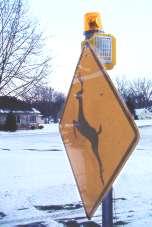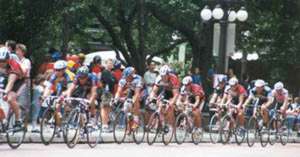 |
 |







|
 |
 |
 |
 |
 |
 |
 moving minnesota through employee communication moving minnesota through employee communication |
 |
 |
 June
13 , 2001 June
13 , 2001 |
No. 18 |
 |
|
|
 |
 |
 |
New deer alert system may lessen motorist-deer collisions in Minnesota
|
 |
 |
 |
|
The deer alert system Mn/DOT is testing in three locations
consists of traditional deer warning signs with an amber beacon mounted
on top. Photo provided by E.L. Lewis Enterprises
|
Motorists may stand a better
chance of avoiding collisions with deer if an experimental deer alert system
Mn/DOT is testing proves effective.
The deer alert system consists of traditional deer
warning signs with an amber beacon mounted on top. Motion sensors are placed
at the far edge of the ditch to create a sensory perimeter. When a deer or
other large animal crosses the path of the sensor, a transmitter activates the
amber warning lights for about one minute. This serves as a visual caution to
drivers to slow down to avoid animals approaching the roadway. The system is
installed along both sides of the roadway to detect deer approaching from either
direction.
After the systems are operational, additional advisory
signs will notify drivers when they are entering a test area and that deer or
other animals may be present when lights are flashing.
The new deer alert systems
will be installed at three locations:
§
Highway 23 at Camden State Park southwest of Marshall (underway)
§
Highway 63 south of Racine (late summer 2001 installation)
§
Highway 43 southeast of Winona (late summer 2001 installation)
Minnesota’s two-year trial of the new warning system
and signs is the first in the nation, according to Bob Weinholzer, Office of
Traffic Engineering. Each test site was selected based on a large deer population
in the area and the number of crashes reported.
Approximately 20,000 vehicle/deer
collisions are reported each year in the state, while an estimated 40,000 additional
crashes are unreported. Two to three motorists’ deaths—the result of crashes
or attempts to avoid collisions—are reported each year. The average vehicle
damage cost in a non-injury crash is estimated at more than $2,000.
"If the deer alert system proves successful at reducing
crashes and saving money for motorists, it could be installed at other areas
with a high deer/motor vehicle collision rate," Weinholzer said.
Twin Cities entrepreneur
Erick Lewis of E.L. Lewis Enterprises developed the deer alert system. Lewis
also invented a system to warn pedestrians about thin ice on Twin Cities area
lakes.
By Kent Barnard
|
back

|
 |
Commissioner’s Forum 6 focuses on streamlining
|
 |
 |
Streamlining creatively was the focus of the commissioner’s forum June 7 in
Minneapolis. Commissioner Elwyn Tinklenberg kicked off the forum with a discussion
about the importance of streamlining and how measuring the value of our efforts
will help Mn/DOT and Minnesota work better.
Dave Labno from The Gatehouse Alliance discussed the importance of including
creativity in all of our tasks to achieve the greatest outcomes. The speaker
challenged the group to brainstorm ideas to design a better bathtub as an example
of improving a tried-and-true product. Forum attendees, indeed, had numerous
ideas for the bathtub improvement including making them self-cleaning and complete
with cable TV. The point of the exercise was to encourage all of us to approach
our jobs with a creative outlook, not overlooking the possibilities for improvement.
Del Gerdes, director of Mn/DOT’s project delivery streamlining team, updated
the 157 managers in attendance on the seven areas his team is focusing on:
§
Consultant process improvements
§
Concurrent project development process
§
Environmental process streamlining
§
Organizational changes
§
Technology advances
§
Right-of-way process improvements
§
Construction plan content evaluation
Three offices—Bridges & Structures,
Communications and Public Relations, and Land Management—gave Moving Mn/DOT
performance update reports. Dan Dorgan, Shannon Beaudin Klein and Karl Rasmussen
shared some of their key dashboards and how they are using these measures to
manage and improve their outcomes. Doug Weiszhaar, Jim Swanson and Pat
Hughes discussed how the use of measures and dashboards is helping the Program
Support and Program Delivery groups work together efficiently and deliver better
products and services to Mn/DOT’s customers.
As at previous commissioner’s forums, Mn/DOT groups recognized individuals
and teams who they think have done an outstanding job of streamlining their
projects and programs. The Program Support and Program Delivery Groups recognized
the District 3 right-of-way section. The State Aid for Local Transportation
Group recognized the Office of Bridges & Structures. The Management
Operations Group recognized the Activity Code Reduction Task Force, and the
Commissioner’s Office recognized the EEO Contract Management office.
The commissioner ended the forum answering questions from the audience. These
questions and answers, plus those the commissioner did not have time to answer
at the forum, will be provided in a future edition of Mn/DOT Newsline.
The commissioner’s comments at the forum were videotaped and will be made available
to all offices and districts for viewing at staff meetings. The next commissioner’s
forum will be held in a district location in September.
By Donna Lindberg
|
back

|
 |
Committee trims down timesheet activity code list
|
 |
 |
Choices,
choices, choices. When there are more than 1,300 numbers to choose from, filling
in the boxes on your timesheet can be time-consuming and confusing. Beginning
July 1, however, a trimmed-down list of activity codes could help make preparing
your timesheet both less confusing and more accurate.
“About 200 codes were eliminated a year ago in pilot efforts by the Office
of Maintenance and the Audit Office,” according to Larry Moser, group business
manager, Management Operations Group. “More recently, a committee charged with
reducing coding efforts has eliminated more than 600 additional codes.”
That trimming effort was recognized last week at the Commissioner’s Forum for
the interdisciplinary, inter-office committee that successfully reduced Mn/DOT’s
Activity Codes list to about 400 codes. Committee members include Doug
Bjornberg, Dennis Feit, MaryAnn Frasczak, Paul Leegard, Dave Munro, Judy Schmidt,
Warren Skallman, Pam Tschida and Brenda Wrobel.
The
streamlining effort occurred in stages over two years, said Moser, who co-chaired
the committee along with Bonnie Kollmann, director, Financial Operations.
Another
goal of the committee was to make it easier for employees to use codes accurately
and consistently, Moser said. This goal led to a new, user-friendly list of
activity codes that:
§
Defines
each active code, and
§
Points
to the replacement for each code that is now inactive.
Moser said that the committee welcomes employee suggestions for making it easier
to use activity codes correctly.
“We realize that we have not necessarily met our goal of having clear definitions
for all codes in all cases,” Moser said. “If you see anything that we can clarify,
tell your office manager or administrative manager.”
Click
here to view the list
of activity codes.
|
back

|
 |
Find employee information on Newsline
|
 |
 |
 |
Today’s Employeeline carries information about
the Touchstone Energy Bicycle Festival, co-sponsored by Mn/DOT, which
is now underway through June 17.
|
You can find Information about the marriages, births,
retirements, funerals and other milestones of your Mn/DOT co-workers online
by clicking on Employee info
on the left hand navigation bar of Mn/DOT Newsline.
Also included in Employeeline are listings
of events of interest to Mn/DOT employees. Today’s edition, for example, carries
information about the Touchstone Energy Bicycle Festival, co-sponsored by Mn/DOT,
which is now underway in Blaine, Plainview and St. Paul through Sunday, June
17.
Because this information will change more frequently
than Mn/DOT Newsline, you may want to bookmark Employeeline in
your browser and check back often.
We need your help in keeping Employeeline
up-to-date and useful. Click on the "Submit Information" button and
send us your announcement, along with your name and phone number.
|
back

|
 |
Question of the Week
|
 |
 |
Question: I understand
there is an idea in San Francisco that eases the traffic problems occuring in
one direction during rush hours. They use movable Jersey walls to convert "north"
bound lanes to "south" bound lanes depending on time of day. They
move the Jersey Walls with trucks having angled bumpers which slide the wall
sections over while the trucks drive down the freeway. In some areas this would
provide lanes in the direction they are needed by using the non-congested side.
Answer: Thank you for the
suggestion and for raising this topic. We are always interested in other agencies’
ideas and in employees’ suggestions.
For more than 30 years Mn/DOT has been trying many different approaches
to ease rush hour congestion in the Twin Cities Metro Area. We also pay close
attention to the results of approaches used by other urban transportation and
public works agencies around the world. We often find intriguing ideas, especially
from areas that are similar to the Twin Cities metropolitan area in the following
ways:
§
Large or moderately-sized
urban areas
§
Demand exceeds capacity on
many freeway segments
§
Active in traffic management
initiatives
§
Have traffic management (or
traffic operations) centers
§
Located in the northern latitudes
The San Francisco area is one of the urban areas we watch, even though many
of their demographics differ from ours. This is because they test and use an
innovative mixture of congestion-easing tactics. For example, they use a wide
array of freeway traffic management systems with many of the same features that
we use. They have a Traffic Management Center for the Bay Area that is located
in the District Office in Oakland, similar to our new Regional Traffic Management
Center currently under construction at the Metro Division Headquarters in Roseville.
They have HOV lanes and toll facilities that are of interest to us. They have
the famous Bay Area Transit System, and also have held onto a portion of their
cable drawn streetcar system, which is unique in the United States.
Some methods that work well for San Francisco are being used in the Twin Cities
area, some have potential, but others look less likely. We have indeed heard
of the approach you’ve suggested, which is also being used in Chicago, and we
have had the vendor for this system present information to us. We are prepared
to use this movable barrier approach if the right situation arises. The main
reason we haven’t been able to use this system in the Twin Cities is that many
of our freeways do not have a large directional split, e.g. 70 percent of the
traffic inbound in the morning and 30 percent outbound. Ours are more like 55
percent inbound and 45 percent outbound, so the “reverse direction” would have
substantial capacity shortfall if we took a lane away and gave it to the other
direction. The geometric constraints of wide medians are another reason we
have not used the movable barriers.
Some of the traffic management initiatives that have worked well in both
the Bay Area and here are surveillance via traffic detectors and CCTV monitoring,
ramp metering, changeable message signs, freeway service patrols (“Highway Helpers”),
and traveler information via radio, TV and web sites. Incident management programs
emphasizing quick detection, response, and removal have been very effective,
and future emphasis on corridor traffic control also shows a great deal of potential.
~Glen Carlson, Metro Division Traffic Engineer
Click here to view previous questions of
the week.
|
back

|
|
|


